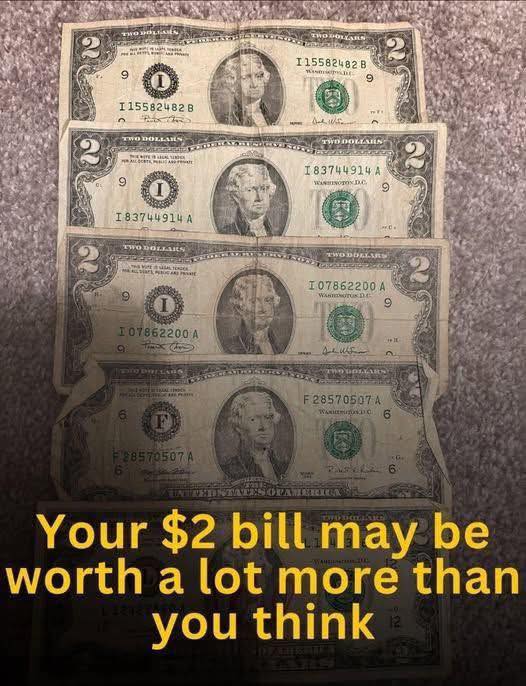For decades, the humble $2 bill has carried a strange reputation — one part superstition, one part mystery, and a dash of misunderstanding. Once dismissed as bad luck or even cursed, the $2 bill has now become one of the most intriguing pieces of U.S. currency. What used to be overlooked and shoved aside might actually be worth hundreds or even thousands of dollars, depending on what’s printed on it.
Most people think $2 bills are rare or even out of circulation. In reality, they’ve never been discontinued — they’re just uncommon. The reason you don’t see them often is simple: people hoard them. Every time someone gets one in change, they assume it’s a collector’s item and stash it away in a drawer. Ironically, that habit is what makes them feel rare. As of 2025, there are still more than a billion $2 bills in circulation, but they’re spread thin because so few are used day to day.
The origins of the superstition go back to the early 20th century. Many gamblers, particularly in horse racing circles, believed $2 bills were bad luck because that was the standard minimum bet at the tracks. Losers often associated their bad runs with the bills themselves. Business owners also disliked them because cash registers and wallets weren’t designed to fit them neatly, and customers didn’t like getting them in change. For a while, some people even tore off a corner of the bill to “break the curse.” Naturally, those damaged notes lost all collector value — which is a shame, considering what some of the surviving bills are worth today.
The first $2 bills were issued in 1862 during the Civil War. They featured a portrait of Alexander Hamilton, not Thomas Jefferson, who appears on them now. In 1869, Jefferson replaced Hamilton, and the reverse side showed Monticello — Jefferson’s Virginia home — in intricate detail. Over the years, several redesigns came and went, but the overall look of the $2 bill hasn’t changed much since 1976, when it was reintroduced to commemorate the U.S. Bicentennial. That version, featuring the signing of the Declaration of Independence on the back, is still the one used today.
The 1976 release was meant to revive interest in the denomination, but it backfired. People thought it was a special commemorative note and refused to spend it. Many banks handed them out for the Bicentennial celebrations, and most recipients promptly tucked them away as souvenirs. So instead of entering circulation, they ended up in collections, drawers, and scrapbooks. Decades later, those same “souvenirs” might be sitting unnoticed — worth far more than two dollars.
So, what makes a $2 bill valuable? It comes down to rarity, serial numbers, printing errors, and condition. Certain runs of $2 bills, especially older ones printed before 1918, can fetch serious money. For example, a 1928 red-seal $2 bill in uncirculated condition can sell for anywhere from $100 to $500. Notes with unique serial numbers — like repeating patterns (e.g., 12341234), ladders (e.g., 12345678), or low numbers (00000005) — can command hundreds more. A bill with a star next to its serial number, known as a “star note,” signals it replaced a misprinted one at the Bureau of Engraving and Printing. Those are especially valuable to collectors.
But even modern $2 bills can surprise you. A 1976 note with a special stamp postmarked on April 13, 1976 — the day of issue — can sell for $50 or more. Certain bills from the 2003 and 2013 series with rare misprints or unique serials have gone for thousands. One example: a misaligned 1976 bill with a double serial number sold for over $2,000 at auction. Condition matters immensely, too. A crisp, uncirculated bill kept flat and clean is always worth more than one that’s been folded, torn, or marked.
It’s not just collectors who find the $2 bill fascinating. There’s also a quiet subculture of people who use them intentionally — as a sort of social experiment. Some business owners and servers hand out $2 bills as tips or change just to spark conversation or to track how far the notes travel. The U.S. Air Force has used them for years at overseas bases to prove American presence; troops spend $2 bills in local towns, and their appearance makes it easy to see where American money circulates. In small communities, the sudden flood of Jeffersons is a subtle reminder of local economic impact.
Beyond collectibility, there’s also cultural nostalgia attached to the $2 bill. Many Americans remember getting one from a grandparent or saving one from a birthday card. It’s become a symbol of luck and thoughtfulness — the opposite of the superstition that once followed it. Some couples include a $2 bill in wedding gifts as a sign of “shared fortune,” and people still slip them into wallets for good luck before trips or big moments.
The irony is that the U.S. Treasury continues to print $2 bills almost every year, but hardly anyone spends them. They cost the same to produce as any other bill, but the low demand means they sit in vaults for years before being distributed. Most banks don’t stock them regularly; you have to ask for them specifically. The government has confirmed repeatedly that they have no plans to discontinue the denomination. In fact, officials encourage people to use them to keep them circulating — otherwise, they’re just paper collecting dust.
If you have a stack of old $2 bills tucked away, here’s how to check if they’re worth more than face value. First, look at the seal color — red seals generally indicate older and rarer series from before 1963. Next, check the serial number for patterns or stars. Finally, inspect the condition: crisp, flat, and well-preserved notes are always worth more. Online price guides and auction listings can help you estimate the value, but if you think you have something special, consult a reputable currency appraiser or take it to a coin show for a professional opinion.
Some lucky collectors have turned forgotten stashes into real money. A man in Texas discovered a stack of 1953 red-seal $2 bills that his grandfather kept in a book; the lot sold for $3,200. A woman in Virginia found a 1917 legal tender $2 note framed behind an old photo — it fetched $1,800 at auction. Even modern bills, if uncirculated and sequentially numbered, can sell for well over $100 per note.
The moral? Don’t underestimate what looks like an odd or outdated piece of paper. The $2 bill might seem like pocket change, but in the right condition, it’s a hidden treasure. And beyond its potential value, it carries a unique slice of American history — one that blends myth, luck, and legacy.
So the next time someone hands you a $2 bill, don’t scoff or stash it away without a second look. Give it a glance, study the numbers, and maybe keep it flat and clean. What looks like two bucks today could be a collector’s prize tomorrow. And even if it never gains a cent in value, consider this: it’s one of the few bills that still sparks a little wonder, a little conversation, and maybe even a touch of luck every time it changes hands.



